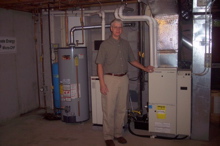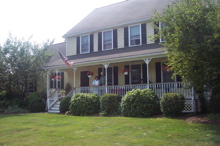Home Power
Air Date: Week of September 14, 2007

David Brownell stands next to the Climate Energy Freewatt cogeneration system in the basement of his house. (Photo: Bruce Gellerman)
A new type of furnace is providing homeowners not only heat but electricity. As the Climate Energy Freewatt furnance warms homes it wins hearts because it can actually run your electric meter backwards. Reporter Prachi Patel-Predd reports on the unique cogeneration plant for houses.
Transcript

David Brownell’s house in Medway, MA. (Photo: Bruce Gellerman)
As Prachi Patel-Predd (Prah-chee pah-tell pred) of I-Triple E Spectrum magazine reports, the unique system can actually run your electric meter backwards and help save energy, money and, perhaps the planet.
[SOUND OF WALKING DOWN STAIRS]
PATEL-PREDD: David Brownell leads the way down to the basement of his colonial home in Medway, Massachusetts. At first glance, the heating system in the basement looks like an ordinary gas furnace. But Brownell’s comes with a few special attachments.
BROWNELL: What we have is a fairly small box the size of a large trash compactor, I suppose, that is the actual engine generator. And this is an internal combustion engine made by Honda. And it is a 160 cc natural gas fired internal combustion engine. To its side is a warm air furnace . . .
PATEL-PREDD: . . . which generates both heat and electricity. The Honda engine burns natural gas to run the generator. A heat exchanger traps the heat and uses it to warm Brownell’s home. It’s sort of like getting the electricity for free. Climate Energy, the Massachusetts-based company that makes this furnace, calls it ‘the free-watt system.’ The trick of generating heat and electricity together is called ‘cogeneration.’ Thomas Edison designed and built the first cogen plant back in 1882. Over the years, cogen plants have been used in hospitals and oil refineries. But now, Climate Energy is making cogeneration systems for homes.

David Brownell stands next to the Climate Energy Freewatt cogeneration system in the basement of his house. (Photo: Bruce Gellerman)
PATEL-PREDD: Cogeneration systems are far more efficient than regular coal-fired power plants, where nearly two-thirds of the heat that’s produced literally goes up in smoke through cooling towers or is lost over transmission lines. Cogen plants, like the free-watt system, are more than 90 percent fuel-efficient. That can make a big difference in utility bills. In test homes, Brownell estimates the system can save seven to eight hundred dollars a year—and help save the planet from global warming.
BROWNELL: So there’s about 15 or 20 homes that were evaluated and the amount of carbon dioxide savings from each of these homes varied from someplace around two and a half tons per year to three tons per year.
PATEL-PREDD: Free watt is mainly a heating system. In seasons that you don’t need heat the machine turns off and you pay your utility for electricity. But when you are using free watt and producing heat, you generate your own electricity. In about 15 states you can sell any extra electricity your system produces back to utility companies. Brownell says it’s a glorious thing to behold.
BROWNELL: The net result to the homeowner is that if they are operating the free-watt system and the electric loads in the house are low like at night time—typical situation—then what will happen is your electric meter will spin backwards.

Yes, David Brownell’s meter actually runs backwards. (Photo: Bruce Gellerman)
BANWELL: So the main market right now is in the northeast United States where you have high electric rates and fairly high number of days when you need to run your furnace. There are other areas of the country where technically you would save a lot in terms of the energy but it would take a little bit longer to pay for itself.
PATEL-PREDD: However, the free-watt system has one feature that could make it attractive just about anywhere.
[SOUND OF MOUSE CLICKING]
PATEL-PREDD: It comes with an Internet connection so you can see and set your home’s cogenerating power plant online from anywhere in the world. And so can your power company. The ability to remotely control the free-watt system could save utilities from building costly power plants. Again, David Brownell.
BROWNELL: One of the things down the road that we can provide is what’s called a ‘virtual power plant.’ And this is a situation where, let’s say you have 1,000 free-watt systems operating in a community like this and there was a brownout about to happen in an area. If there was an agreement in place and the utility was on board and the homeowner was on board, the utility could flip a switch and instantly turn on 1,000 free watts and have a 1.2-megawatt power plant operating right where they need it.
PATEL-PREDD: Here in the United States, the home cogeneration industry is in its infancy. Keyspan is the first—and so far—only utility to offer rebates for the furnaces. But in Japan, the UK, and Germany, cogen is soaring. There, governments and big utilities are helping customers buy cogen systems with tax credits and price discounts. Matt Dugan, Keyspan’s manager of residential energy efficiency programs, says the same thing is needed here.
DUGAN: The state and the federal government do offer tax credits on energy efficient installations in homes and businesses and it’s quite possible that this technology—once in the marketplace—may be identified as one that could receive a tax credit down the road.
PATEL-PREDD: If that happens, cogen systems like free watt could generate a lot of heat and shed some light on America’s quest for energy independence. For Living on Earth, this is Prachi Patel Predd.
CURWOOD: Prachi Patel-Predd is a reporter with I –Triple E Spectrum Magazine. For photos and more information about the free-watt system, check out our web page: L-O-E dot org.
Links
Living on Earth wants to hear from you!
Living on Earth
62 Calef Highway, Suite 212
Lee, NH 03861
Telephone: 617-287-4121
E-mail: comments@loe.org
Newsletter [Click here]
Donate to Living on Earth!
Living on Earth is an independent media program and relies entirely on contributions from listeners and institutions supporting public service. Please donate now to preserve an independent environmental voice.
NewsletterLiving on Earth offers a weekly delivery of the show's rundown to your mailbox. Sign up for our newsletter today!
 Sailors For The Sea: Be the change you want to sea.
Sailors For The Sea: Be the change you want to sea.
 Creating positive outcomes for future generations.
Creating positive outcomes for future generations.
 Innovating to make the world a better, more sustainable place to live. Listen to the race to 9 billion
Innovating to make the world a better, more sustainable place to live. Listen to the race to 9 billion
 The Grantham Foundation for the Protection of the Environment: Committed to protecting and improving the health of the global environment.
The Grantham Foundation for the Protection of the Environment: Committed to protecting and improving the health of the global environment.
 Contribute to Living on Earth and receive, as our gift to you, an archival print of one of Mark Seth Lender's extraordinary wildlife photographs. Follow the link to see Mark's current collection of photographs.
Contribute to Living on Earth and receive, as our gift to you, an archival print of one of Mark Seth Lender's extraordinary wildlife photographs. Follow the link to see Mark's current collection of photographs.
 Buy a signed copy of Mark Seth Lender's book Smeagull the Seagull & support Living on Earth
Buy a signed copy of Mark Seth Lender's book Smeagull the Seagull & support Living on Earth

